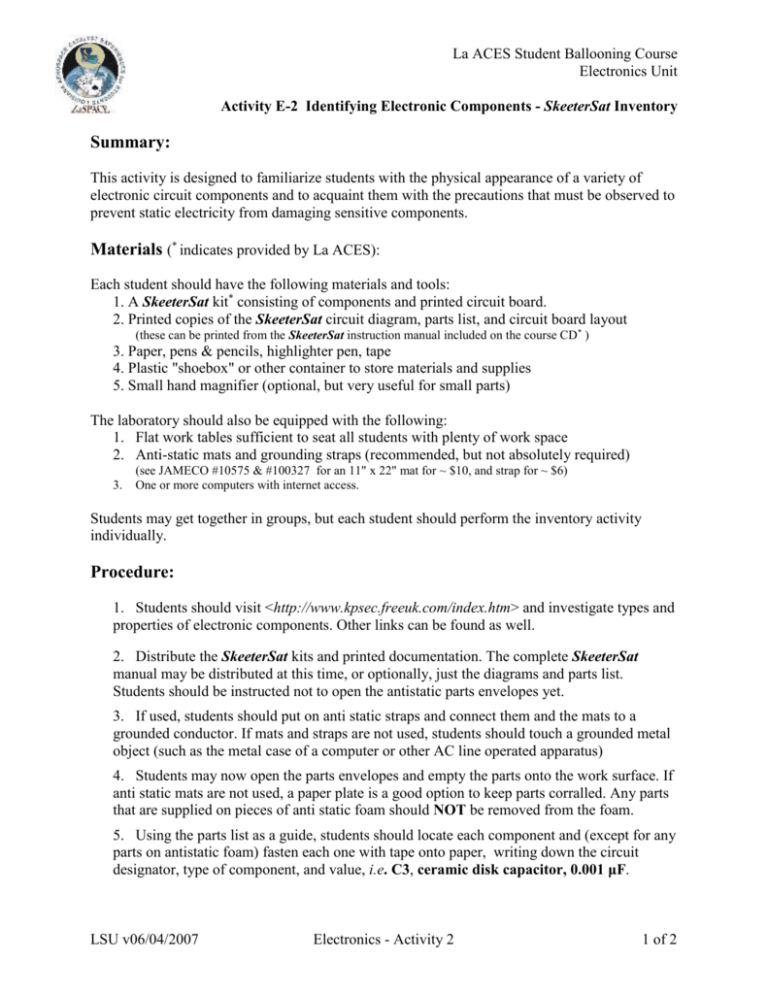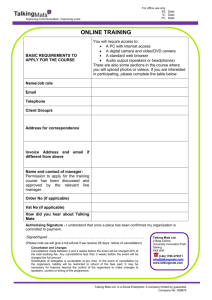Identifying Electronic Components
advertisement

La ACES Student Ballooning Course Electronics Unit Activity E-2 Identifying Electronic Components - SkeeterSat Inventory Summary: This activity is designed to familiarize students with the physical appearance of a variety of electronic circuit components and to acquaint them with the precautions that must be observed to prevent static electricity from damaging sensitive components. Materials (* indicates provided by La ACES): Each student should have the following materials and tools: 1. A SkeeterSat kit* consisting of components and printed circuit board. 2. Printed copies of the SkeeterSat circuit diagram, parts list, and circuit board layout (these can be printed from the SkeeterSat instruction manual included on the course CD* ) 3. Paper, pens & pencils, highlighter pen, tape 4. Plastic "shoebox" or other container to store materials and supplies 5. Small hand magnifier (optional, but very useful for small parts) The laboratory should also be equipped with the following: 1. Flat work tables sufficient to seat all students with plenty of work space 2. Anti-static mats and grounding straps (recommended, but not absolutely required) 3. (see JAMECO #10575 & #100327 for an 11" x 22" mat for ~ $10, and strap for ~ $6) One or more computers with internet access. Students may get together in groups, but each student should perform the inventory activity individually. Procedure: 1. Students should visit <http://www.kpsec.freeuk.com/index.htm> and investigate types and properties of electronic components. Other links can be found as well. 2. Distribute the SkeeterSat kits and printed documentation. The complete SkeeterSat manual may be distributed at this time, or optionally, just the diagrams and parts list. Students should be instructed not to open the antistatic parts envelopes yet. 3. If used, students should put on anti static straps and connect them and the mats to a grounded conductor. If mats and straps are not used, students should touch a grounded metal object (such as the metal case of a computer or other AC line operated apparatus) 4. Students may now open the parts envelopes and empty the parts onto the work surface. If anti static mats are not used, a paper plate is a good option to keep parts corralled. Any parts that are supplied on pieces of anti static foam should NOT be removed from the foam. 5. Using the parts list as a guide, students should locate each component and (except for any parts on antistatic foam) fasten each one with tape onto paper, writing down the circuit designator, type of component, and value, i.e. C3, ceramic disk capacitor, 0.001 μF. LSU v06/04/2007 Electronics - Activity 2 1 of 2 La ACES Student Ballooning Course Electronics Unit Activity E-2 Identifying Electronic Components - SkeeterSat Inventory 6. At the completion of the inventory parts may be stored, still taped to their paper sheet, in the project box in preparation for SkeeterSat schematic study and assembly in subsequent activities. Expected Outcomes: 1. Learn to relate circuit symbols and part designations to actual components. 2. Learn to read the value coding on components 3. Become comfortable with anti-static handling procedures. Issues: 1. Emphasize anti-static measures, either occasional "touch grounding" or use of mats and straps. Keep devices on the anti static foam as required. 2. The color code for resistors ought to be committed to memory. Check if any students are color blind. About 10% of males are red-green color blind, but it's rare in females. Red and orange can look very similar on some components. 3. Be sure everything is stored neatly at the end of the activity. References: 1. SkeeterSat Assembly and Operations Manual. Part of La ACES Student Ballooning Course documentation. LSU v06/04/2007 Electronics - Activity 2 2 of 2





